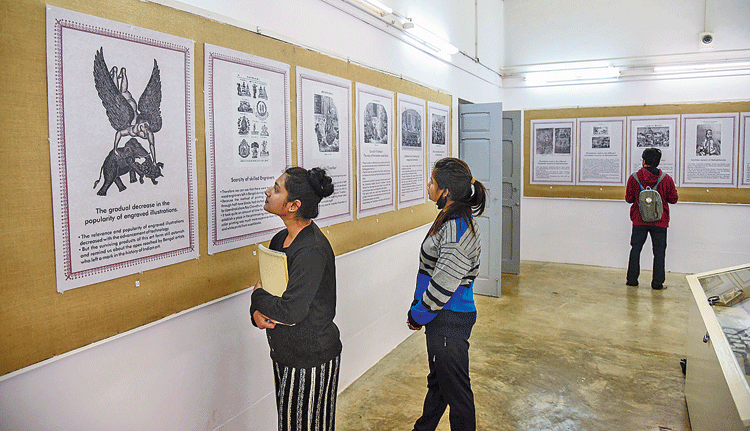An exhibition on Bengal’s 19th century tradition of printing illustrations using wooden blocks has began at the Visva-Bharati’s Kala Bhavan.
The 12-day-long exhibition, which is being held at the Nandan art gallery on the campus, was inaugurated on Monday morning by artist and professor emeritus of Kala Bhavan Jogen Chowdhury. The exhibition will continue till February7.
Around 91 illustrations printed in various editions of the epic Mahabharata during the period 1860 to 1910, along with a dozen of printmaking blocks made of box-wood, are on display at the exhibition.
Jyotirmoy Bhattacharya, a freelance art curator from Calcutta who collected the printing from several old books obtained from his grandfather and personal sources, said the items would help visitors and students to know the history of printmaking prevalent in the 19th century.
“I have collected those with my effort of at least 10 years. We can’t imagine how the book and mainly the illustration in those books was a tough job in the nineteenth century. It was not like today’s digital printing. I have displayed the first printed book in Bengali fonts — ‘A Grammar of the Bengal Language’ written by Nathaniel Brassey Halhed in 1778. I have also displayed a reprint of engraved illustration of ‘Annadamangal’, which was published in 1816, the first illustrated book in Bengali,” said Bhattacharya.
A book “Sangit Taranga”, which was published with engraved illustration in 1818 is also on display at the exhibition.
The Kala Bhavana authorities said that the exhibition was quite different compared to other art exhibitions as the engraved illustrations of “Mahabharata” and the wooden blocks used to print books would help students know about the history of Bengali printmaking in its early ages.
“We have organised the exhibition as we think that it will help students of arts, Bengali literature and history to know and research on printing techniques of the nineteenth centuries. The exhibition will interest even those not associated with printing,” said Amit Danda, the curator of Kala Bhavan.
The exhibition also gives a peek into the history of printing illustration and how it was tough to print in a book. “Using several small tools illustrations were engraved on wooden blocks. Later, it was printed on one side of a paper using pressure,” said a teacher of Kala Bhavan.










